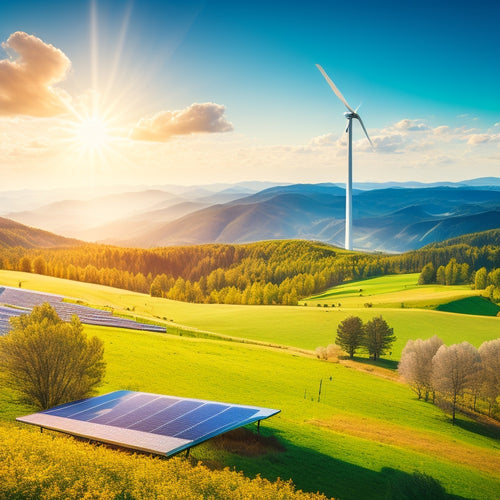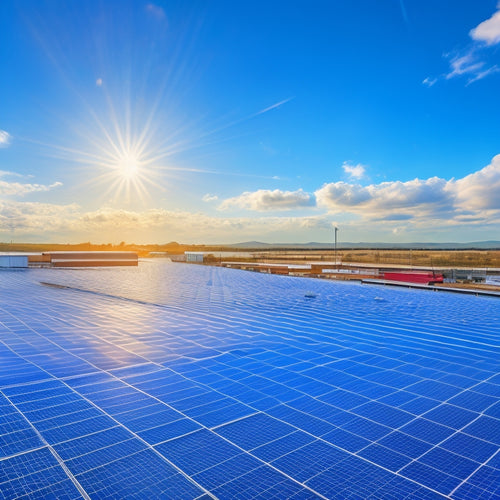
What Makes a Solar Energy Roof Different
Share
A solar energy roof differs from traditional roofs as it integrates advanced photovoltaic technology, enabling you to utilize solar power directly. This system enhances energy independence by greatly reducing reliance on utility companies, translating to long-term cost savings of $10,000 to $30,000 over its lifespan. Innovative solar tile designs offer up to 22% efficiency while maintaining aesthetic appeal, blending seamlessly with your home's design. Roof material also plays an essential role, influencing installation and energy production. Understanding these factors can help you make informed decisions for your energy future, and there's more to investigate about maximizing your solar investment.
At a Glance
- Solar energy roofs integrate photovoltaic technology into roofing materials, allowing them to generate electricity while serving as a functional roof.
- They provide greater energy independence by reducing reliance on utility companies and lowering monthly energy bills.
- Modern solar tiles offer advanced energy efficiency, with some achieving up to 22% efficiency and reflecting excess heat to improve cooling.
- Aesthetic options allow solar roofs to blend seamlessly with various architectural styles, enhancing property values without sacrificing visual appeal.
- Long-term cost savings and available tax incentives make solar roofs a financially appealing investment for homeowners.
Energy Independence Potential
By installing solar energy roofs, you can greatly reduce your dependency on utility companies, leading to increased energy independence.
Over time, the long-term cost savings from utilizing solar energy can outweigh the initial investment, providing a stable financial return.
As energy prices fluctuate, this independence not only shields you from rising costs but also enhances your overall energy security.
Reduced Utility Dependency
Energy independence emerges as a powerful motivator for adopting solar energy roofs, allowing homeowners to greatly decrease their reliance on traditional utility providers. By utilizing solar energy, you can substantially reduce your monthly energy bills and increase your control over energy consumption. High solar panel efficiency translates to more energy generated from the same amount of sunlight, allowing you to maximize your energy independence.
When you install solar energy roofs, the grid connection impact becomes a vital factor. A well-designed system can allow you to produce enough energy to meet your needs without relying heavily on the grid. This reduces vulnerability to fluctuating energy prices and enhances your ability to manage energy production and consumption.
The ability to generate your own power encourages a sense of freedom and security, particularly in an era where energy demand is rising.
Moreover, advancements in battery storage technology mean you can store excess energy for later use, further decreasing dependence on utility providers. Essentially, adopting solar energy roofs not only promotes sustainability but also enables you to take charge of your energy future, minimizing the influence of external energy markets on your life.
Long-term Cost Savings
Over the lifespan of a solar energy roof, homeowners often experience considerable long-term cost savings that extend well beyond initial installation expenses. By investing in solar technology, you can greatly reduce or even eliminate your monthly electricity bills, making your financial planning more predictable.
Studies show that homeowners can save anywhere from $10,000 to $30,000 over 20 to 30 years, depending on energy consumption and local utility rates.
In your budget analysis, consider the rising costs of conventional energy sources, which can lead to unforeseen spikes in your monthly expenditures. By utilizing solar energy, you gain a degree of energy independence, insulating yourself from these fluctuations.
Additionally, many states offer tax incentives and rebates for solar installations, further enhancing your potential savings.
Moreover, solar roofs can increase your property value, providing an additional long-term return on investment. When you evaluate the financial implications, it becomes clear that solar energy roofs aren't just an environmental choice; they're a savvy economic decision.
Ultimately, switching to solar enables you to take control of your energy expenses, ensuring a more stable and secure financial future.
Cost Savings Over Time
When you install solar energy roofs, you're not just making a one-time investment; you're setting yourself up for significant long-term energy savings.
By leveraging financial incentives, such as tax credits and rebates, homeowners can lower their upfront installation costs.
Over time, reduced utility bills can offset the initial costs, and federal or state tax incentives can enhance your financial return.
Long-term Energy Savings
Investing in solar energy roofs can yield significant long-term cost savings that often surpass initial installation expenses. As you utilize the power of solar panel efficiency, you're not just reducing your monthly utility bills; you're also gaining energy independence. The average homeowner can save upwards of $20,000 over 20 years, depending on local energy rates and sunlight exposure.
Moreover, integrating energy storage solutions allows you to store excess energy generated during peak sunlight hours. This capability further enhances your savings by enabling you to use stored energy during high-demand periods, which typically incur higher costs. A battery system can provide substantial savings, especially during utility rate spikes or outages.
Additionally, as energy prices continue to rise, your locked-in solar energy costs will become increasingly favorable. With inflation-adjusted savings, the financial benefits compound, making solar roofs not just a sustainable choice but a savvy economic decision.
Over time, the return on investment amplifies, leading to a significant reduction in overall energy expenditure. Embracing solar technology isn't merely about reducing bills; it's about securing your financial freedom while contributing to a more sustainable future.
Tax Incentives Benefits
The financial advantages of solar energy roofs extend beyond just long-term savings; tax incentives greatly enhance these benefits. When you install a solar energy roof, you can utilize federal tax credits that allow you to deduct a significant percentage of the installation costs from your federal income taxes. Currently, this credit stands at 26%, providing substantial upfront savings.
Coupled with this, many states offer additional incentives, which can include rebates, property tax exemptions, or performance-based incentives. These state incentives vary widely, but they can further reduce your initial investment, making solar energy roofs even more attractive.
For example, some states may refund a portion of your investment directly, while others may provide ongoing payments based on your energy production. In total, when you account for federal tax credits and state incentives, your cost savings over time can be considerable.
This financial structure not only enables you to reduce your energy bills but also cultivates a sense of independence from traditional energy sources. By taking advantage of these incentives, you're investing in a sustainable future while enjoying immediate cost benefits.
Innovative Solar Tile Design
As you investigate innovative solar tile designs, you'll notice how these products seamlessly integrate with various building styles while enhancing aesthetic appeal.
Current advancements focus on maximizing energy efficiency, allowing for improved performance without sacrificing the visual elements of your roof. By adopting these designs, you can achieve both functionality and beauty in your solar energy solutions.
Additionally, these solar tiles contribute to minimal environmental impact by supporting a sustainable future and promoting energy independence.
Aesthetic Integration With Architecture
Innovative solar tile designs offer a fascinating solution for homeowners seeking to merge sustainability with building aesthetics. These tiles not only provide energy efficiency but also enhance visual aesthetics through diverse color choices and texture options. By prioritizing style compatibility, these designs achieve architectural harmony, guaranteeing they complement various architectural styles, from contemporary to historical.
To illustrate how these elements integrate, consider the following table:
| Design Element | Impact on Aesthetics |
|---|---|
| Color Choices | Enhance visual appeal, adapt to surroundings |
| Texture Options | Add depth, create interest |
| Style Compatibility | Guarantee cohesion with architectural design |
Today's design trends emphasize material integration, allowing solar tiles to blend seamlessly into roofing systems. Landscaping considerations further influence tile choice, as homeowners aim for a cohesive outdoor environment. Additionally, cultural influences may guide selections, reflecting local heritage and historical relevance. With innovative solar tile designs, you can accomplish an energy-efficient roof that aligns with your aesthetic preferences, allowing for freedom in both style and sustainability.
Enhanced Energy Efficiency Features
Utilizing advanced technology, modern solar tiles greatly improve energy efficiency by maximizing sunlight absorption and conversion. These innovative designs enhance solar panel efficiency through optimized surface textures and materials that capture a wider range of sunlight.
Research shows that advanced photovoltaic cells can achieve up to 22% efficiency, considerably increasing energy generation optimization compared to older models.
Furthermore, the integration of micro-inverters allows each tile to perform independently, ensuring that shading or debris on one tile doesn't compromise the entire system's output. This decentralized approach raises overall energy production, giving you the freedom to utilize solar power effectively, regardless of environmental conditions.
Additionally, many modern solar tiles are designed to reflect excess heat, reducing the thermal load on your roof and improving cooling efficiency within your home.
This dual benefit not only boosts your energy generation but also lowers your reliance on traditional energy sources, promoting sustainability.
Selecting Based on Roof Type
When selecting solar energy roofs, you need to evaluate the specific material of your roof, as different types can impact installation efficiency and energy production.
For instance, asphalt shingles typically allow for easier integration of solar panels compared to clay tiles, which may require more complex mounting solutions.
Additionally, materials like metal roofs offer high reflectivity and durability, enhancing overall solar efficiency.
Understanding these material differences will help you assess the installation challenges and potential energy yield of your solar system.
Roof Material Considerations
Selecting the right roof materials for solar energy integration requires careful consideration of both the roof type and the specific characteristics of the materials themselves. You'll want to evaluate material durability and installation methods to guarantee your solar energy roof meets your energy needs effectively.
Here's a quick guide on common roof materials and their compatibility with solar installations:
| Roof Material | Material Durability | Recommended Installation Methods |
|---|---|---|
| Asphalt Shingles | Moderate | Conventional mounting |
| Metal | High | Direct attachment |
| Tile | High | Rail systems |
| Slate | Very High | Specialized mounting |
| Membrane | Moderate | Adhered systems |
Each of these materials presents unique considerations. For instance, metal roofs provide superior durability and can facilitate effective solar panel attachment, while tile roofs may require more specialized installation methods due to their weight and structure. By understanding the interplay between these factors, you can confidently choose the right roof materials that align with your solar energy goals, guaranteeing a long-lasting and efficient system.
Installation Challenges Faced
Installing solar panels on different roof types presents various challenges that can impact both the efficiency and longevity of your solar energy system. Each roof type requires specific installation techniques to guarantee peak performance and safety.
For instance, a flat roof may necessitate ballasted systems, while pitched roofs often use mounts that demand precise structural assessments.
Weather considerations also play a critical role; heavy snowfall or high winds can affect the type of materials and methods used. You'll need to account for the local climate during installation to prevent future roof repairs and make certain that your system remains operational.
Labor requirements can vary greatly based on the roof's complexity. More intricate designs often lead to higher labor costs and extended installation times.
Adhering to safety protocols is paramount to protect workers and the integrity of your home during the installation process.
Navigating the permitting processes can be another hurdle, as local regulations may vary.
Aesthetic Integration With Architecture
When considering solar energy roofs, seamless design elements are essential for aesthetic integration with your structure.
Studies show that homes with well-integrated solar solutions not only enhance visual appeal but also increase property values by up to 15%.
Seamless Design Elements
Seamless design elements in solar energy roofs not only enhance aesthetic appeal but also integrate harmoniously with existing building styles. When you choose solar roofs, you're opting for design innovation that aligns with your structural vision.
Advanced solar aesthetics allow for integration that doesn't disrupt your home's character. Instead, these roofs can mimic traditional materials like slate or tile, ensuring they complement rather than clash with your home's design.
Data shows that homes featuring solar energy roofs can increase property value by up to 14%. This increase often stems from the visual appeal and modernity of the seamless designs.
Furthermore, these roofs employ state-of-the-art technology, such as photovoltaic shingles, that maintain a low profile while capturing solar energy efficiently.
You're not just adding a power source; you're embracing a modern design statement. This integration enables you, giving you the freedom to express your personal style while contributing to energy sustainability.
With seamless design elements, you can enjoy the benefits of solar energy without sacrificing the charm of your home, creating a striking balance between functionality and aesthetic appeal.
Frequently Asked Questions
How Do Solar Roofs Perform in Extreme Weather Conditions?
Solar roofs excel in extreme weather due to their energy efficiency and weather resilience. They withstand heavy winds, hail, and snow, ensuring your energy needs are met while protecting your investment and promoting energy independence.
What Maintenance Is Required for Solar Energy Roofs?
To maintain your solar energy roof, schedule regular solar panel inspections and perform solar roof cleaning as needed. This guarantees peak performance, extends lifespan, and maximizes energy efficiency, allowing you to enjoy the freedom of renewable energy.
Can Solar Roofs Be Installed on Flat Roofs?
Installing solar roofs on flat roofs is like laying a solid foundation for a skyscraper. You've got various flat roof options, and precise installation techniques guarantee peak energy capture and durability, enabling your energy independence.
Are Solar Roofs Suitable for All Geographic Locations?
Solar roofs aren't universally suitable; their efficiency varies by geographic energy potential. You'll need to assess local sunlight exposure, climate conditions, and regulations to determine if a solar roof meets your energy needs effectively.
How Long Do Solar Energy Roofs Typically Last?
Solar energy roofs typically last around 25 to 30 years. The installation process can impact longevity, but their cost benefits often outweigh initial expenses, providing sustainable energy solutions while enhancing your property's value and freedom from utility dependency.
Explore More
To conclude, a solar energy roof changes your home into a lighthouse of sustainability, offering energy independence and long-term cost savings. With innovative tile designs customized to your roof type, you can seamlessly integrate aesthetics and function. By choosing solar, you're not just adopting a technology; you're investing in a brighter future. Just as a seed grows into a mighty tree, your decision today can yield significant benefits for both your wallet and the environment tomorrow.
Related Posts
-

Renewable Energy Solutions to Reduce Your Carbon Footprint
To reduce your carbon footprint, adopting renewable energy solutions is key. Using solar panels or wind turbines can ...
-

Commercial Solar Energy
As you consider powering your business with commercial solar energy, you'll uncover it offers a triple benefit: signi...
-

High-Efficiency Solar Battery Chargers for Remote Areas
High-efficiency solar battery chargers are essential for your off-grid energy needs in remote areas. They maximize en...


